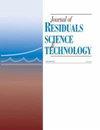Enzymatic Treatment of Organics in Tannery Effluent
引用次数: 0
Abstract
This study investigates the ability of enzyme technology to treat organics in tannery effluent. Three bacteria strains were tested for their ability to remove organic matter in tannery effluent, and the active sites of the respective enzymes were determined. Subsequently, the active enzymes that remove organics were extracted from the three strains and tested for the optimal activity of tannery effluent under different temperatures, pHs, concentrations, and incubation times. The results demonstrated that all three strains (Bacillus subtilis, Bacillus cereus, and Bacillus fusiformis) are able to remove organics in the tannery effluent. The active enzyme of Bacillus subtilis is an intracellular enzyme, whereas the active enzymes for Bacillus cereus and Bacillus spindle are extracellular enzymes. At pH 7, Bacillus subtilis and Bacillus cereus can, respectively, remove 37.79% and 35.34% of the organic waste in tannery water at 40°C. Bacillus fusiformis can remove up to 49.60% of the organic waste when the incubation time is extended to 8 h. The enzyme concentration is fixed at 2 × 10–4g for all conditions. In this study, enzyme technology provides a novel approach for organic removal in a tannery effluent treatment, and it has the potential to be combined with other methods in the future.酶法处理制革废水中的有机物
研究了酶法处理制革废水中有机物的能力。测试了三种细菌对制革废水中有机物的去除能力,并确定了各自酶的活性位点。随后,从三种菌株中提取去除有机物的活性酶,并在不同温度、ph值、浓度和孵育时间下测试制革厂废水的最佳活性。结果表明,这三种菌株(枯草芽孢杆菌、蜡样芽孢杆菌和梭状芽孢杆菌)都能去除制革废水中的有机物。枯草芽孢杆菌的活性酶是胞内酶,蜡样芽孢杆菌和梭形芽孢杆菌的活性酶是胞外酶。pH为7时,枯草芽孢杆菌和蜡样芽孢杆菌在40℃下对制革水中有机废物的去除率分别为37.79%和35.34%。当培养时间延长至8 h时,梭状芽孢杆菌对有机废物的去除率可达49.60%。在所有条件下,酶浓度固定为2 × 10-4g。在这项研究中,酶技术为制革厂废水处理中的有机去除提供了一种新的方法,并且在未来有可能与其他方法相结合。
本文章由计算机程序翻译,如有差异,请以英文原文为准。
求助全文
约1分钟内获得全文
求助全文
来源期刊

Journal of Residuals Science & Technology
环境科学-工程:环境
自引率
0.00%
发文量
0
审稿时长
>36 weeks
期刊介绍:
The international Journal of Residuals Science & Technology (JRST) is a blind-refereed quarterly devoted to conscientious analysis and commentary regarding significant environmental sciences-oriented research and technical management of residuals in the environment. The journal provides a forum for scientific investigations addressing contamination within environmental media of air, water, soil, and biota and also offers studies exploring source, fate, transport, and ecological effects of environmental contamination.
 求助内容:
求助内容: 应助结果提醒方式:
应助结果提醒方式:


